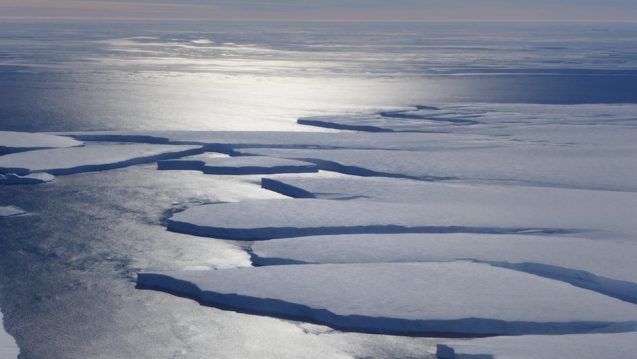Year by Year, Line by Line, We Build an Image of Getz Ice Shelf
Changes in Antarctic ice have been dominated by the interaction of the ice and the ocean, and because ice shelves extend out into the water they are vulnerable to melt from the warmer ocean water. Melt can affect them in two ways, through thinning along their length and through causing a retreat of the “grounding line.”

Antarctic ice appears in a range of types and sizes, from the newly formed skim of ice on the ocean called grease ice (above), to the older meter thick layers of sea ice, to chunks of icebergs, floating reaches of ice shelves, and finally the massive land based Antarctic ice sheet. Each part of this ice inventory has a unique role in the larger climate system, but they also work together. As part of this year’s IceBridge Antarctic flight campaign, we are focused largely on the coastline to build a better understanding of the interaction of these different pieces in the ice system. This understanding is central to improving our climate models.

The focus today is on Getz ice shelf. Ice shelves form when ice flows off the land into the surrounding ocean, forming a thick apron of attached, but floating ice. The Getz shelf extends out several miles from where the glacier empties into the ocean. The shelves are deep floating blocks of ice ~ a km thick where they first meet the ocean and thinned to several hundred meters thick at their front edge. They are critical for the future stability of the Antarctic ice sheet as they provide a barrier that holds back the continental ice sheet, braking its flow from land into the ocean.

In all ~ 45 ice shelves adorn almost half the Antarctica coastline, and represent an area of ~1.5 million km², close to 10 percent of the total ice that covers Antarctica. Ten of these are considered major shelves, with the largest two nestled in the junctures where East and West Antarctic meet, filling in the space with California-sized blocks of ice: the Ross Ice Shelf (at 472,960 km²), where Lamont-Doherty currently has another Antarctic research project called Rosetta running, and the Filchner-Ronne (422,420 km²) across from it. Many of the shelves are smaller, yet each serves a valuable role in Antarctic ice stability, and thus they are a prime focus for examining change in Antarctica.

Changes in Antarctic ice have been dominated by the interaction of the ice and the ocean, and because ice shelves extend out into the water, they are vulnerable to melt from the warmer ocean water. Melt can affect them in two ways, through thinning along their length and through causing a retreat of the “grounding line.” The grounding line is the critical spot where the ice goes from being frozen all the way to the ocean floor (or bed) to where it begins to float in the ocean. The grounding line retreat results from warm water melting the ice back from its frozen base. Tracking any changes to the location of the grounding line tells us a lot about the vulnerability of the ice shelf and is critical to setting models.

Getz ice shelf is our furthest flight mission of the campaign at close to 12 hours of flying, and it is our fifth mission this week, with each one clocking 11 plus hours of flight with prep and wrap-up added on either end. It could feel a bit like a rerun of the same movie, but it never does, and the wear of the long days doesn’t appear to show on the team. The purpose of today is to continue mapping the sub ice-shelf bathymetry using our gravimeter, as well as the ice surface and bedrock upstream of the grounding line using laser and radar. We need a complete look at the grounding line and the bed under the ice shelf, where warm ocean water can move in and circulate under the ice, in order to improve our models. Gravity is critical for uncovering the surface depths and contours under the ice shelves, as none of the other instruments on board are able to collect data through the water that lies under the shelf.

Because of the distance to Getz from our daily starting point in Chile, we have been building a set of data over a series of years, line by line. Each year we collect a repeat track and a new track. We know Getz has changed. Eighteen months ago in March 2015, a NASA image from space captured a Manhattan-sized iceberg (17 miles long) breaking off of Getz Ice Shelf. This break appears to have occurred at the end of the last austral summer in late February. Today we can see large sections of ice that will soon be calving, but what this means will need to be matched to the other measurements we are collecting before we know the full set of changes in Getz.
IceBridge: Since 2009, the NASA IceBridge project has brought together science teams to monitor and measure each of the ice features in order to improve our understanding of changes in the climate system and our models. Lamont-Doherty, under lead scientists Jim Cochran and Kirsty Tinto, has led up the gravity and magnetics measurements for these campaigns. This season alone, the project has logged 195 hours of flight time to date, and flown an equivalent of a third of the way to the moon. You can read about earlier IceBridge expeditions to Antarctica and Greenland on State of the Planet, here and here.
Save
Save
Save
Save
Save
Save
Save
Save
Save
Save
